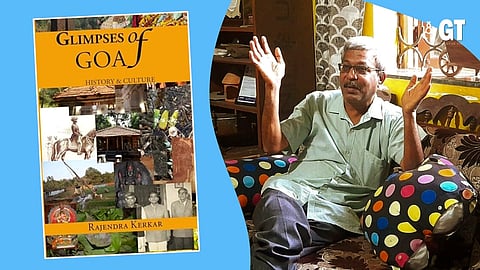

Rajendra Kerkar is a man who thinks deep, stays where the depth of freshness can be felt and through his new book, the 5th in English, Glimpses of Goa – History and Culture, establishes a connect with the past.
The 30-chapter book that runs into 149 pages feels like a rustle heard when one walks over fallen dried leaves, and as author Kerkar says, “Brings unknown facts of my land to the people.”
Living close to the confines of the forest, Kerkar has seen and lived life in the wilds of the Western Ghats of Goa and his book helps the reader not only realise the hidden gems but begin a connect – if there didn’t exist one before.
Folk dances, folk songs, rock art, festivals, rare vegetable dishes and biodiversity are themes that Kerkar takes the reader through and a chapter on crocodiles shows the deep lineage of a man who is fighting to save Mhadei and the tigers in Goa.
Folk dances, folk songs, rock art, festivals, rare vegetable dishes and biodiversity are themes that Kerkar takes the reader through.
Glimpses of Goa could have had a better literary polish but that is not of concern because as Kerkar points out, “the book is to get the people to go, see the places and get a better understanding.”
Crocodiles for many is an animal coated with tales and in chapter 18 of his book, “Crocodile in Goan culture”, Kerkar mentions “the legend pertaining to the introduction of crocodiles in the waters of the River Mandovi.”
A chapter on crocodiles shows the deep lineage of a man who is fighting to save Mhadei and the tiger in Goa.
“The Portuguese chronicler, Joao de Barros, mentions that the city of Goa was protected by crocodiles, with which the river abounded, and which were enormous enough to devour whole bullocks and upset large boats.”
“It is believed that the crocodiles have been introduced as guards against surprise attacks and the escape of slaves. When Alfonso Albuquerque conquered Goa on November 25, 1510, crocodiles were fed all the criminals during their incursion into Portuguese territory.”
“During the old times, crocodiles survived the Muslim and the Portuguese rulers,” writes Kerkar whilst going on to say, “Crocodile is a sanctified reptile in Goa.”
Sores of illegal mining are well indited by Kerkar and are made alive in the chapter on ‘Unique facets of Lamgao’. The book, whilst bringing out the beauty of the place cries about how mining has robbed the place of its rich biodiversity.
The book, whilst bringing out the beauty of the place cries about how mining has robbed the place of its rich biodiversity.
Despite mining, the people of Lamgao still carry on their shoulders the beauty of the place – see GT Daily, Lamgao Village resolved to prevent restart of mining – uploaded on August 10, 2023.
Glimpses of Goa is a glimpse of not just the hinterland but the people who add zest to life through their lifestyle, their thinking and community living.
As one rustles through the pages, the urge to go back to the wilds of Goa resurfaces though often tagged down by the fact – often mentioned by Kerkar – that Goa of the old is slowly dissipating due to greed.
Rajendra Kerkar’s 5th book in English, though not a literary piece, is a good addition to a library, especially for readers who want to preserve Goa’s identity at least through prose and is available on Amazon.